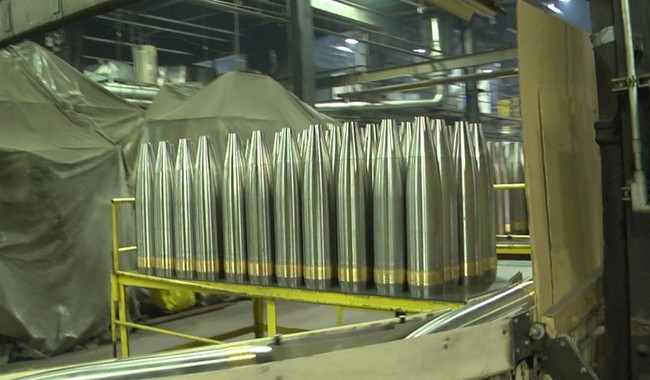


There is an apocryphal story in military circles that supposedly comes out of North Africa during World War 2. A British Colonel, strolling the docks, is fascinated by the steady stream of American ships unloading: Artillery shells, tanks, trucks, guns, rifle ammo, gasoline, guns, K-rations, medical supplies, fighter aircraft, guns, anti-tank mines, guns, and more guns. American industrial might was well and truly on display, the United States having turned our massive industrial plant to a full war footing. The British Colonel is said to have remarked, "The Americans don't so much solve their problems as overwhelm them."
That was then. This is now. And, thanks to years of shipping munitions to other parts of the world so other countries can shoot them at their enemies, our munitions stocks have grown alarmingly low. That, now, may finally be changing.
Congress has been pouring money into the armed forces’ organic and defense industrial bases (the former is government-owned and the latter is contractor-led). Those investments are starting to pay off. And still more is to come , thanks to the One Big Beautiful Bill Act for defense.
As realization sinks in across the Defense Department that America’s military magazine depth is far too shallow, actions are underway to reverse course and increase the “health of the shelf” of the nation’s munitions production levels.
Army leaders told Congress they’ve “invested $4.9 billion to build new [munitions] production lines and add new capacity and resiliency to our supply chains across the country.”
Here's the catch: We haven't been ramping up our production, not in any significant sense, since 1945. That's a problem. Our troops can have the best training, the best support, the best technology, and even the best weapons in the world, but without ammo, all of that is of no more consequence than a kid's pea-shooter.
Ammo's what's needed. And now, under the leadership of President Donald Trump and Secretary of Defense Pete Hegseth, munitions production will be picking up again.
Just a few weeks ago, a new fully automated 155mm artillery shell production factory called UNION Technologies opened outside of Dallas, Texas. This comes on the heels of another new load, assembly, and pack munitions facility that opened in Arkansas in April.
Also on the heels came a May ribbon-cutting at Crane Army Ammunition Activity in Indiana for a new explosive railcar holding yard. This was the “first time in many decades” the Army has done this, leaders told Congress. The expansion will double the output from this location after the Army found—no surprise—that inadequate rail holding space in times of heavy demand reduced readiness.
And:
Also, thanks to recent new funding, the Radford Army ammunition plant is integrating advanced chemical processing capabilities into its manufacturing lines. This is the sole nitrocellulose and propellant manufacturing site in the US, built in, you guessed it: 1941.
This is what needs to happen. To trot out another military truism, there is no problem that cannot be solved with a suitable application of high explosives - but we have to have the explosives for that to work.
Read More: Pentagon Halting Some Munitions to Ukraine: We Can't Afford It
Navy Chief Makes 'Alarming' Comment About How Fast US Going Through Munitions
The One Big, Beautiful Bill is providing for the rebirth of America's munitions industries, and it's about time. This isn't a new crisis, either; when I was recalled to active duty in 1996 for the Balkans fracas, I remember talking to a colleague who indicated that in those years of Bill Clinton's "peace dividend," infantry soldiers were only firing their weapons once a year, for annual qualification. These were riflemen, the heart of any nation's armed forces. Infantry. Riflemen. Firing their rifles once a year.
That's changing.
The One Big Beautiful Bill Act recently allocated an additional $25.3 billion for munitions, missiles, counter-drone, and supply chain investments. As necessary, the bill establishes three munitions reserve programs to expand capacity. Specifically, the bill allocates $1 billion for the expansion and acceleration of qualification activities and technical data management to enhance competition in the defense industrial base, and an additional $500 million for the expansion of defense advanced manufacturing techniques in munitions.
One of the few legitimate roles of government, any government at any level, is to protect the liberty and property of the citizens. At the national level, that means running the military - the Army, Navy, Air Force, the Marine Corps, the Coast Guard, and now the Space Force. For them to do their jobs - to close with and destroy the enemy by fire, maneuver, and shock effect - they need ammo, and plenty of it. One of the keys to success in modern warfare is volume of fire; no war was ever lost by having too much ammo.
America's munitions industry is coming back. Let's just hope it comes back fast enough.
Editor's Note: Thanks to President Trump and Defense Secretary Pete Hegseth's leadership, the warrior ethos is coming back to America's military.
Help us report on Trump and Hegesth's successes as they make our military great again. Join RedState VIP and use promo code FIGHT to get 60% off your membership.
